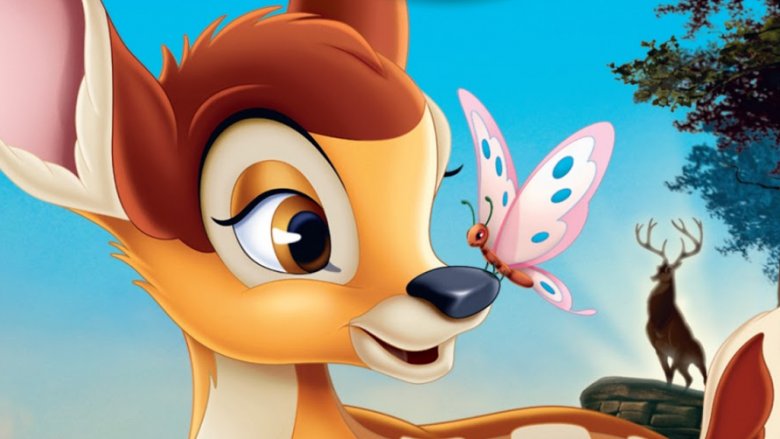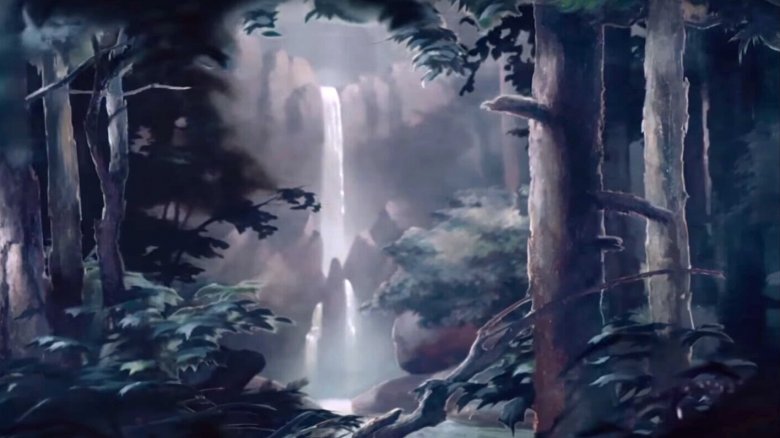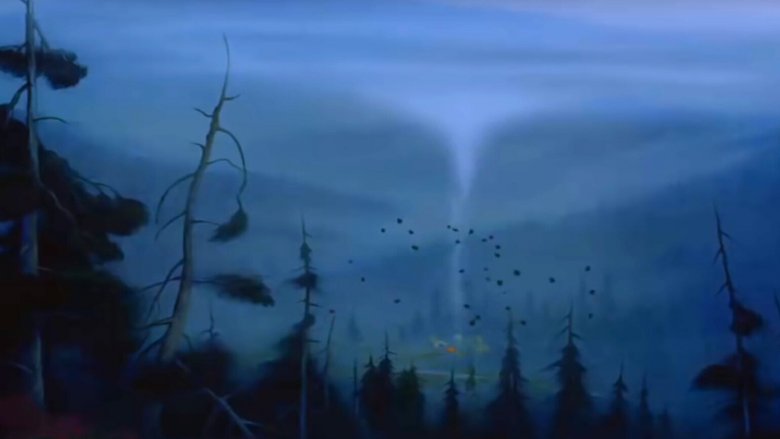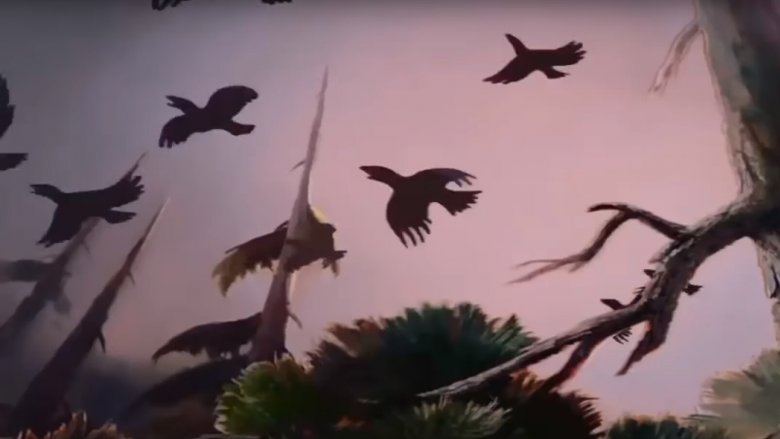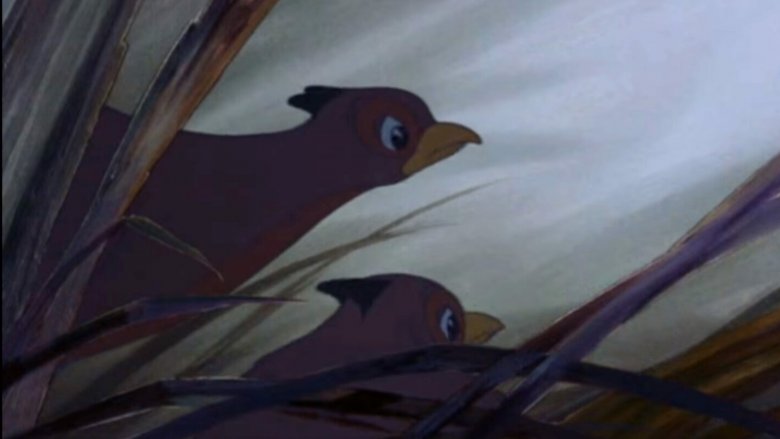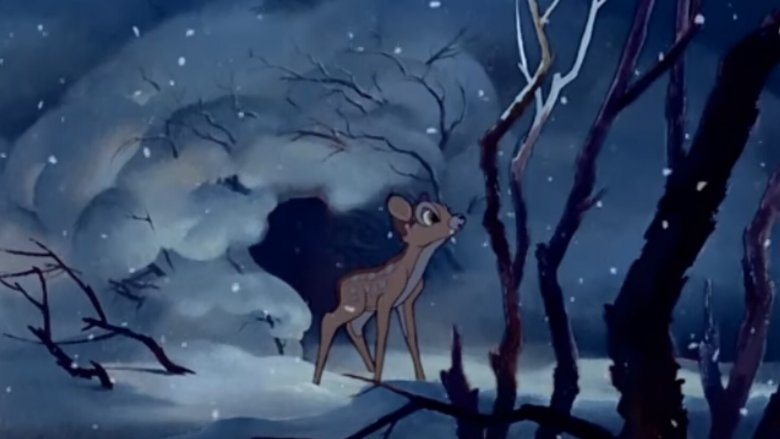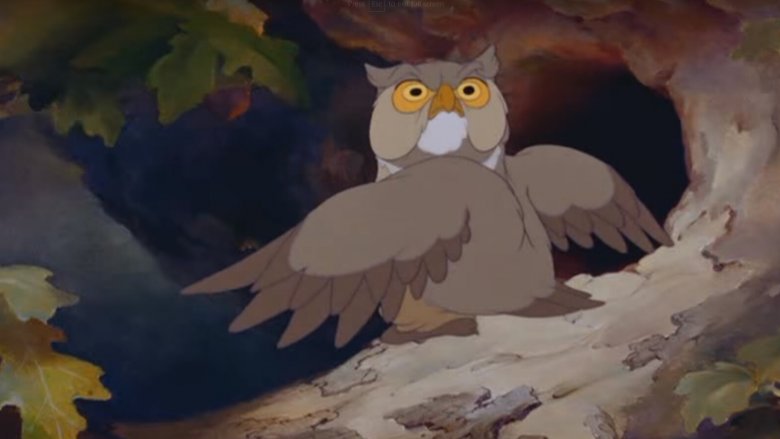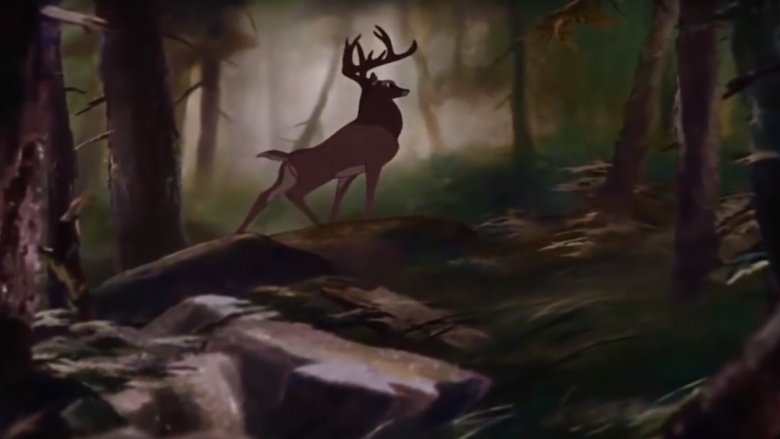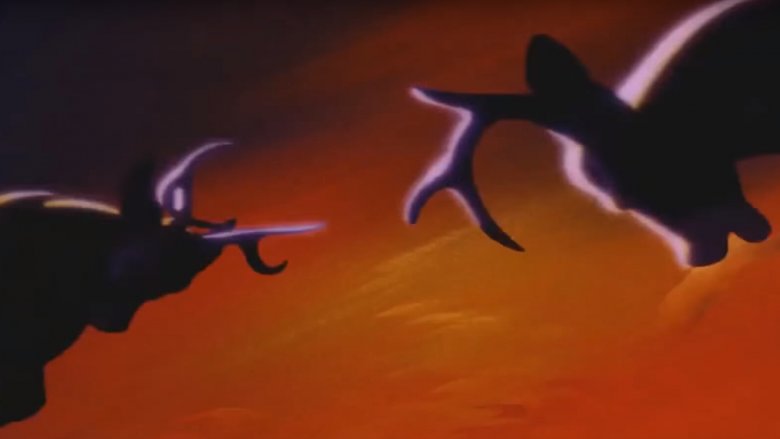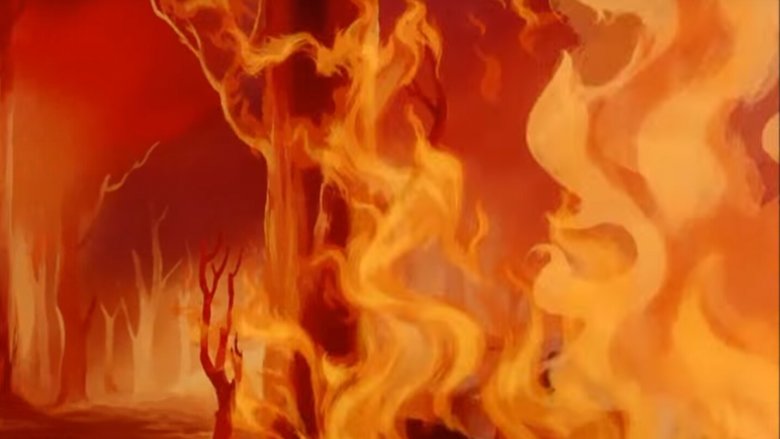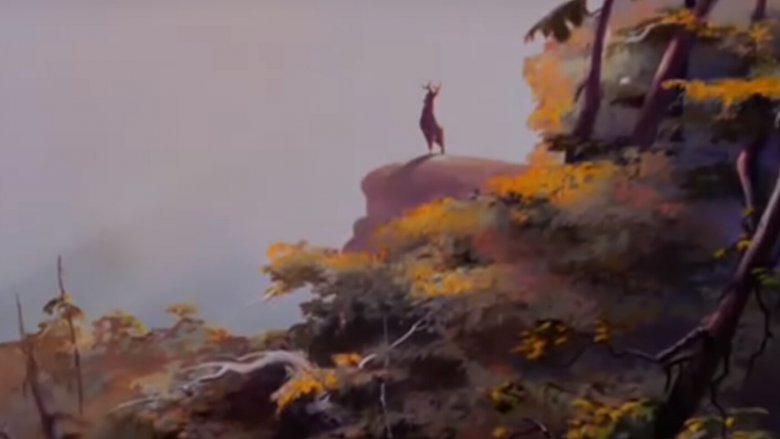Why Bambi Is Actually Terrifying
Being scared is good for kids. Maybe. It's a topic of debate for psychologists, but many parents believe that allowing their children to be exposed to frightening elements in fiction can help them develop coping skills for real-life traumas. Storytellers throughout history have certainly believed that, from the Brothers Grimm to R.L. Stine. But no one in the modern age may be more responsible for spooking youths than Walt Disney.
There are plenty of intense scenes all throughout the Disney canon, but the studio's early forays into animated features remain a particular golden age of nightmares. There's Snow White's flight through a haunted forest, Dumbo's pink elephant hallucinations, and who could forget the horrific donkey transformation scene in Pinocchio?
And then there's Bambi, the 1942 classic based upon Felix Salten's novel that's been traumatizing kids for generations. While other Disney masterpieces put their heroes through moments of anxiety, this tale of a little forest prince is saturated with dread, permeated with loss, and punctuated with terror. If you think that's an exaggeration, join us as we explore the beautiful brutality of Bambi.
The naturalism
The foundation for Bambi's terror lies in the unflinching way it turns its lens on nature. As Disney's fifth feature-length motion picture, there was very little precedent for realism in their output. Though they strove for drama and believable human characters from the very beginning with Snow White, they had still been dealing mostly in the realm of fantasy and fairytale. Buying a ticket to a Disney movie meant you could expect magical guardians, stars that granted wishes, and kisses that could resurrect the dead.
Bambi signals a change in this mindset from the very beginning, as the backgrounds (supervised by art director Tyrus Wong, the movie's secret weapon) set the stage for a forest that's closer to an impressionist painting than a cartoon wonderland. Compared to Snow White's animal friends of just a few years prior, Bambi's characters are strikingly lifelike, the result of intensive study by the animators. We may hear them talk every now and then, but these are not the noodle-limbed caricatures seen in other animation of the era. The world of Bambi is our own, and while it may be beautiful, there's no magic here to protect you in its darker corners.
The enemy is Man...
Wicked witches. Wacky sorcerers. Crackpot criminals. Disney antagonists are so often graced with elements of fantasy or comedy that they become fan favorites, outlandish scene-stealers the audience loves to hate. Not so with Bambi, where the villain is simply a grim specter of death who threatens the gentle balance of the wood...and his name is Man.
We never see the man in question, and "Man" is the only name he is ever called. Whether it's the same singular hunter haunting these woods or a faceless group is irrelevant. He represents all of mankind. Bambi forces us to confront the idea that we are a destructive force. Hunting is such a pervasive hobby (or lifestyle, for some) that countless kids have surely had to grapple with the notion that there's no difference between their own dads and the terror on the screen. Not exactly a concept you're prepared for while you're looking at drawings of birds and bunnies.
...and he is unknowable
Man remains always offscreen, spoken of by the animals in hushed, fearful tones. The citizens of the forest don't fully understand his motives, and they can't predict when he will appear next or what he will do. The only things that signal his presence are his campfire, his bullets, and his ominous theme music.
We, the audience, may understand what a hunter does, but putting us in the point of view of the animals frames Man as a shapeless, existential threat to safety and order. For us, he can represent any number of fears lurking in our subconscious, and we can relate to the terror of the woodland creatures because we too must constantly grapple with unpredictable dangers we can't comprehend. In fact, it's easy to imagine that people watching Bambi during its original release in 1942 may have been reminded of World War II as it threatened to engulf the entire globe.
Fatal fear
One small but particularly shocking moment in Bambi concerns a minor character with a mere 30 seconds of screen time, but who nonetheless makes a deep impression. During Man's hunt, we meet a pheasant struggling to fend off a panic attack as the villain draws nearer. Her friends make every effort to talk her down and keep her lying low in the grass, but the fear slowly takes control as her terror rises in pitch.
When she can't take it anymore, the pheasant bolts off in flight. A moment later, a shot rings out, and we watch as her corpse thuds to the ground, setting off all the others in a riot of flight. It's a scene that builds and releases tension as masterfully as the finest horror movie, and its unflinching close-up of a character losing her wits is as discomforting as any R-rated thriller. By zooming in tight on this one poor soul, the movie shows how the very act of being afraid could literally kill you.
Your mother can't be with you anymore
They may be the seven most devastating words in movie history. As the entire forest flees from the encroaching lethality of man, Bambi's mother orders him to keep running and not look back. We don't see her fall, but the gunshot lets us know what's happened before Bambi does, and we're left to wait for his slowly dawning realization that she's gone. As he wanders alone through a dense, moody snowfall calling out for her, he encounters his father, the Great Prince of the Forest, who delivers the somber truth: "Your mother can't be with you anymore."
Bambi wouldn't be the last Disney protagonist to lose a parent, but something about his plight has remained in our cultural consciousness for decades. Maybe it's that feeling of natural realism, or maybe it's the particular vulnerability of a young deer. The atmospheric isolation of the gently falling snow certainly enhances the moment. Whatever the reason, it's undeniable that the murder of Bambi's mother will continue to devastate generations of children and adults alike.
Tonal whiplash
As the newly motherless Bambi disappears into the forest with his father, the movie immediately transitions to "Let's Sing a Gay Little Spring Song," a musical number that finds the birds of the forest twittering cheerfully about the love in the air. It's an almost obnoxiously cheerful tune, dripping with sweetness as if it were a parody of overly precious Disney songs.
The juxtaposition of this warbling with the sequence of desolation and loss that precedes it is sort of hilarious, yes. But it also quietly underscores one of Bambi's major themes: that life goes on in the face of horror and death. It's actually a comforting idea in the big picture, but for that moment, the lack of time to grieve (compare it to The Lion King, in which we watch Simba struggle with his father's death for quite some time) underscores the intensity of what Bambi has had ripped away from him.
Deadbeat deer dad
Turning protagonists into orphans is a standard implement in the Disney sympathy toolbox. We would need a whole separate article, if not an entire recurring column, to count down the saddest stories of cartoon children who have lost one or both parents. Usually, though, they soon find a caring guardian to protect them or a funny mentor to take them under their wing.
Bambi, however, is left with his father, which almost worse. The so-called Great Prince of the Forest may be a noble protector and an inspiring figure, but he has a sense of cold detachment that makes him a less than comforting presence. Bambi doesn't even know that the mysterious figure watching over the woods is his father until halfway through the movie. More than six decades later, Disney released Bambi II, a sequel that picks up in the middle of the original and tells the story of the Great Prince's efforts to find someone else to raise Bambi while he tends to his important duties. Real warm, Your Majesty.
The inevitability of it all
Many children's stories are about young heroes overcoming great odds, changing their worlds, or making their dreams come true. Kids and adults alike are inspired by messages that say if you work hard enough, journey far enough, or wish on the right star, you can have what everyone says you can't. The poor girl marries the prince, the ancient curse is broken, the puppet becomes a real boy. Bambi is not one of those stories.
Time and time again, we watch as Bambi must give himself over to the whims of an uncaring universe. Take, for instance, the scene in which Friend Owl tells Bambi, Thumper, and Flower that they will soon become "twitterpated." The young trio is horrified by this description of being in love, and vow to never fall victim to such feelings. But animal instincts soon kick in, and all three are fawning over potential mates. Even Bambi's strikingly intense battle with rival male Ronno for the affections of the lovely doe Faline feels more like a matter of overwhelming biology than pride or purpose.
The fire
Disney fans love a good climactic showdown between the hero and the villain. Animation can allow for a big, rousing spectacle of fantasy that elicits cheers from the audience. There's The Sword in the Stone's magic duel, Ursula growing to gargantuan size in The Little Mermaid, and Jafar's snake transformation in Aladdin, just to name a few. We all love to watch villains go big and fall hard.
Bambi, though, builds to a conclusion that's much more terrifying than it is dazzling. Man returns with a whole party of hunters, but rather than giving its hero a chance for justice, the movie delivers a massive forest fire. Man remains the antagonist, as his carelessness with his campfire is what sparks the blaze to begin with. But fire is, of course, a force of nature itself, and the flames rapidly consume the trees. Our heroes all narrowly manage to survive, but the sight of the entire world we've known for the whole movie burning to the ground around them is nothing short of haunting.
The Circle of Life
Bambi is rife with parallels to another movie that would join it in the Disney canon 52 years later: The Lion King. They're both rare examples of all-animal casts in entirely naturalistic settings. Each features the devastating murder of a parent. And though only one of them has an entire song about it, both stories are dedicated first and foremost to illustrating "the Circle of Life."
Both Bambi and The Lion King begin with the birth of an animal prince and end with their ascent to the throne as their own heirs are born. Simba gets a truly uplifting ending, in which his enemies have been defeated and we have every reason to believe that the next generation will have things better than the last. Bambi, however, gets no such catharsis as he watches over his mate and child from a distance, just as his own father did.
Man will inevitably return while the animals carry on under the guidance of their own instincts. All the pain and struggle of growing up that we've seen through Bambi's eyes will continue in an endless cycle for his children and their children. That's the way of nature, and that's what makes Bambi as terrifying as it is beautiful.
